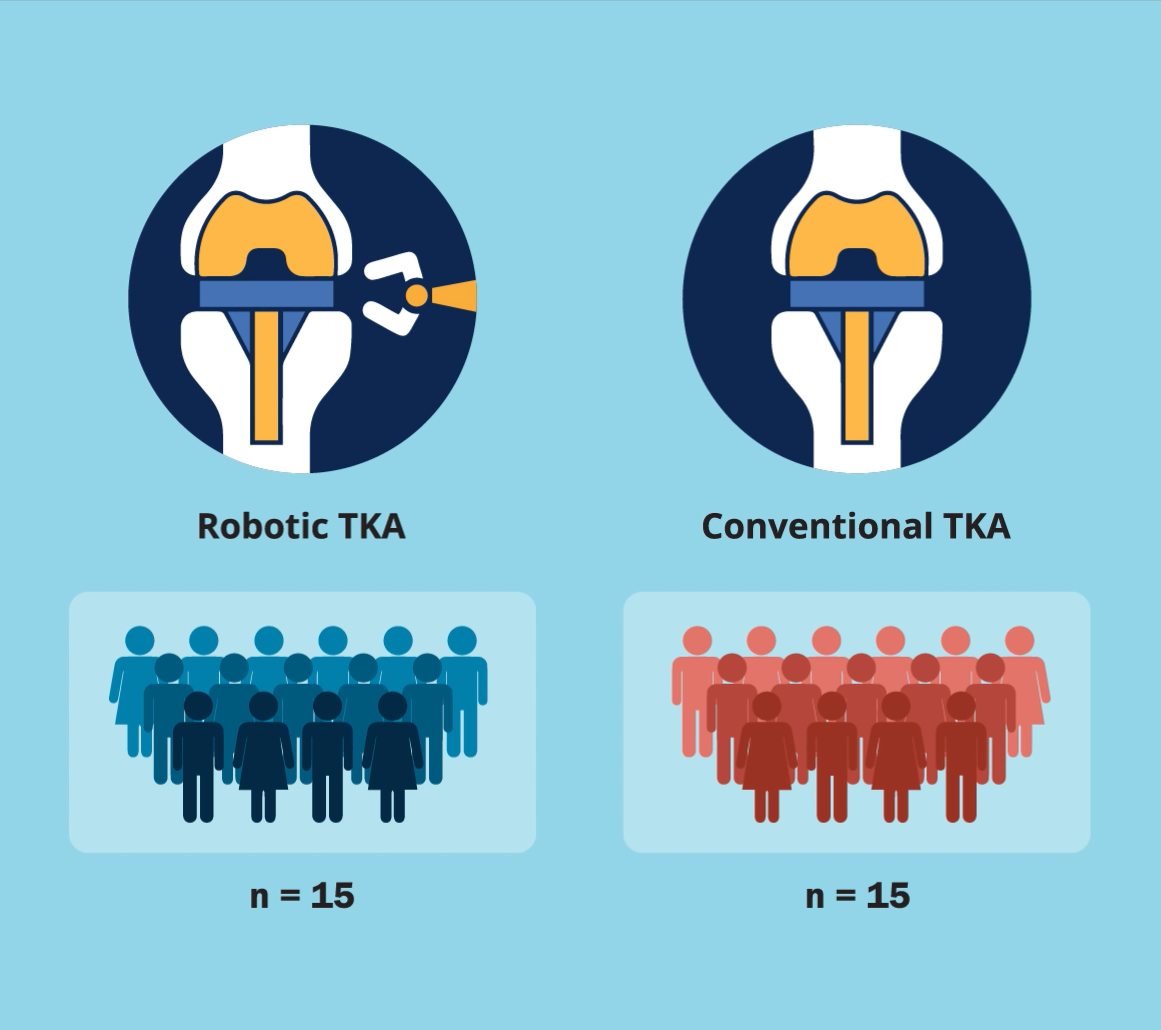A new JBJS study by Fontalis et al. compares the inflammatory response in robotic-arm-assisted total knee arthroplasty (TKA) vs. conventional jig-based TKA. The investigators also assessed the relationship with early functional outcomes.
As noted in the study, patients may report dissatisfaction with TKA despite its good mid- to long-term clinical outcomes and low revision rates. Surgical trauma is a potential contributing factor to dissatisfaction, say the investigators, as it may lead to inflammatory responses that influence clinical recovery and functional outcomes.
The researchers recently conducted a randomized controlled trial comparing robotic-assisted and conventional TKA, assessing serum inflammatory markers at select postoperative time points1. They found a significantly lower systemic inflammatory response at 7 days for robotic TKA. They also found less iatrogenic soft-tissue injury and bone trauma among the patients in the robotic TKA group.
They hypothesized that robotic TKA would be associated with a reduction in local inflammation.
Study Highlights
- In the current Level-I analysis, the investigators sought to produce pilot data on local inflammatory response by measuring the levels of inflammatory markers obtained from intra-articular drain fluid (at 6 and 24 hours). They also evaluated functional outcomes and patient-reported outcome measures (PROMs) at 2 years, to explore any potential correlation with local and systemic inflammation.
- Included were 15 patients with symptomatic knee osteoarthritis who underwent conventional TKA, and 15 who underwent robotic-arm-assisted TKA.
Findings
- The patients in the robotic TKA group had lower levels of interleukin (IL)-6 at 6 and 24 hours and a lower level of IL-8 at 6 hours.
- Patients who underwent robotic TKA had lower pain scores on postoperative days 1, 2, and 7.
- At 2 years, PROM scores were comparable between the 2 groups. However, the small sample size precluded the ability to identify statistically significant differences in PROMs.
- The authors found significant correlations between all serum markers except IL-1b and self-reported pain on day 7. They also found a moderate correlation between IL-6, IL-8, and tumor necrosis factor-alpha levels at 6 hours and knee flexion or extension.
Conclusions
The authors concluded that robotic-arm-assisted TKA was associated with a reduction in the early postoperative local inflammatory response. In addition, they found “a moderate relationship between the inflammatory responses and self-reported pain, knee flexion, and knee extension.”
They emphasize the need to validate their findings in a larger study and obtain longer-term data, noting that this “will be key to developing the optimal TKA procedure.”
Access the full JBJS report along with a video summary.
A commentary on this study is provided by Sébastien Lustig, MD, PhD: “More Science and Less Passion Around Robotic Surgery”
References
- Kayani B, Tahmassebi J, Ayuob A, Konan S, Oussedik S, Haddad FS. A prospective randomized controlled trial comparing the systemic inflammatory response in conventional jig-based total knee arthroplasty versus robotic-arm assisted total knee arthroplasty. Bone Joint J. 2021 Jan;103-B(1):113-22.




Robots are not made all equal. Similarly robotic assisted surgery are not the same and specific differentiation between products should be made.
For example, the standard approach to MAKO assisted surgery (marketed by Stryker) involved pre-operative CT scanning for planning virtual boundary, whereas ROSA® by Zimmer-Biomet can proceed with “imageless option” or “2D X-ray to 3D bone modeling imaging based on X-Atlas® technology” (ref 1) for determining bone resections. THINK surgical TSolution-One® (Robodoc) (ref 2) requires “preoperative radiography (anteroposterior, lateral, skyline, long-leg films) and computed tomography (CT) of the affected lower limb” for the “active-autonomous, image-based, robotic milling system”.
Clearly the primary focus of each system’s approach is different while trying to achieve similar (but not necessarily the same) goals and it is surprising that in the entire paper the only time “MAKO” is mentioned is in the title of one of the referenced paper.
There is likely to be a difference in outcome between systems, yet to be proven, but it is important to understand that the word “robotic-assisted surgery” for total knee replacement is as nebulous as calling a car to describe a Volvo 740, Toyota Prius and Lamborghini Aventador as a group.
References
1. https://www.zimmerbiomet.com/en/products-and-solutions/specialties/knee/rosa–knee-system.html#01-overview
2, https://www.ncbi.nlm.nih.gov/pmc/articles/PMC5663203/